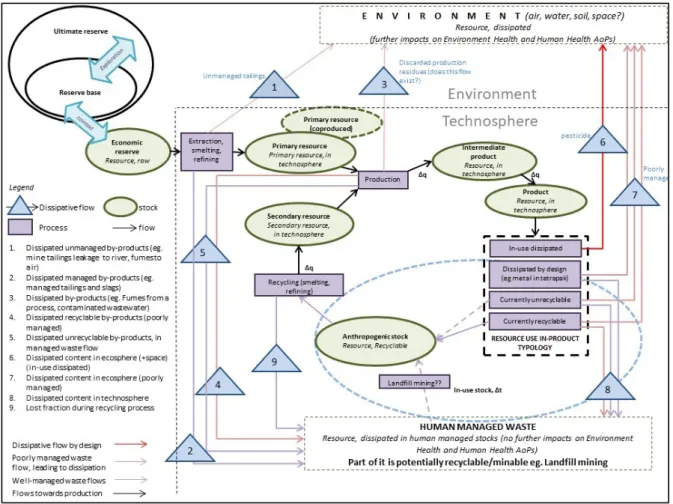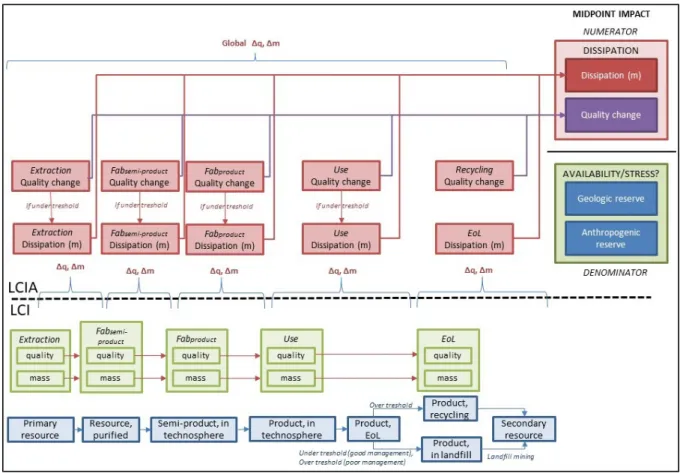Science Arts & Métiers (SAM)
is an open access repository that collects the work of Arts et Métiers Institute of Technology researchers and makes it freely available over the web where possible.
This is an author-deposited version published in: https://sam.ensam.eu Handle ID: .http://hdl.handle.net/10985/15143
To cite this version :
Alexandre CHARPENTIER-PONCELET, Guido SONNEMANN, Bertrand LARATTE, Philippe LOUBET, Stéphanie MULLER, Jacques VILLENEUVE - Development of a conceptual framework and its associated indicator to take the dissipation of non- energetic abiotic resources into account within Life Cycle Assessment (LCA) In: 16 e Colloque National Smart, France, 20190403 -Colloque National S-mart - 2019
Development of a conceptual framework and its
associated indicator to take the dissipation of
non-energetic abiotic resources into account within Life
Cycle Assessment (LCA)
Alexandre Charpentier Poncelet
Groupe CyVi
Institut des sciences moléculaires (Université de Bordeaux) 351 Cours de la Libération
33405 Talence – France
alexandre.charpentier-poncelet@u-bordeaux.fr
Bertrand Laratte
Institut de Mécanique et d’Ingénierie, Ecole nationale supérieure des arts et métiers (ENSAM)
Esplanade des Arts et Métiers 33400 Talence – France
bertrand.laratte@ensam.eu
Stéphanie Muller
BRGM
3 Avenue Claude Guillemin 45100 Orléans – France
s.muller@brgm.fr
Guido Sonnemann
Groupe CyVi
Institut des sciences moléculaires (Université de Bordeaux) 351 Cours de la Libération
33405 Talence – France
guido.sonnemann@u-bordeaux.fr
Philippe Loubet
Groupe CyVi
Institut des sciences moléculaires (Université de Bordeaux) 351 Cours de la Libération
33405 Talence – France
philippe.loubet@enscbp.fr
Jacques Villeneuve
BRGM
3 Avenue Claude Guillemin 45100 Orléans – France
j.villeneuve@brgm.fr
Life Cycle Assessment (LCA) is a tool allowing to assess environmental impacts of a product or service over its whole life cycle. It may serve as a support for product eco-design, policy-makers and decision-takers in governments and industries. LCA is relatively new, and methodological improvements are still required for it to be as robust as possible in order for it to fulfill its function and to be considered reliable and credible. A proper method to assess resource use in LCA has yet to be developed. In this regard, our work in progress is aiming at a better understanding and assessment of resource use impacts on Natural Resources Area of Protection in LCA with a dissipation approach.
abiotic resources, life cycle assessment, dissipation, metals, minerals
I. INTRODUCTION
In order to face challenges concerning increasing resource uses in modern societies, much interest and efforts have been put towards a more circular economy in recent years, and measures which are promotive of resource efficiency are now being put into motion. Life Cycle Assessment (LCA) may play an important role in supporting decision-takers in institutions
of natural resource efficiency without an impact shift towards other environmental concerns.
Recent developments for the Natural Resources Area of Protection (AoP) in LCA have put current methods tackling resource use under review by many (e.g. [1], [2]). It has been proposed that the safeguard subject for mineral resources is their capacity to fulfill provisioning functions for humans (materials, energy, food, space, etc.) (perspective 2 from [3]). Therefore the damage on resources should be quantified as the reduction or loss of this capacity caused by human activity. Dissipation has been identified as a relevant approach for this perspective compared to methods based on resources depletion [4]. It allows a better identification of where resource are lost (dissipated), including within the technosphere, and as a consequence lose their potential value for human use. However, no consistent method has been developed to include dissipation within LCA thus far.
II. METHODOLOGICAL DEVELOPMENTS
In this regard, we propose to build a conceptual framework to include dissipation of metals and minerals within LCA. “Key elements”, such as dissipation occurring during extraction, production and use, quality limits (e.g. physicochemical limits, including thermodynamics, after which the resource will be permanently lost as an emission or as a final stock within mine tailings or end of life discharge), resource occupation in the technosphere, recycling rates and quality loss are defined in order to make this approach functional. Approaches to measure or evaluate such key elements, and the way their implementation within Life Cycle Inventories (LCI) or Life Cycle Impact Assessment (LCIA) can be done, are presented. Feasibility of the implementation of these elements within the LCA methodology is evaluated and planned future works based on this initial framework are presented.
III. CONCEPTUAL FRAMEWORK – WORK IN PROGRESS
A. Life cycle inventories
So far, elements to be captured within this new indicator approach have been identified. Life cycle inventories should allow to capture mass loss (dissipation) and quality changes within a product’s life cycle. Figure 1 shows an overview of the life cycle of a resource within a product, and potential mass and quality changes happening for different life cycle stages. A geological reserve is to be taken into account, as well as an anthropogenic stock, for which elements to be considered are included within the dotted circle (human managed waste and in-use products.
Future works will aim at identifying which information is available within current available inventories (e.g. ecoinvent) and which additional data would need to be gathered to optimize the LCIA quality and reduce uncertainties.
Figure 1. OVERVIEWOFTHELIFECYCLEOFANABIOTICRESOURCE, WITHDISSIPATIVELOSSESANDQUALITYCHANGES (ΔQ)
B. Life cycle inventory and life cycle impact assessment relationships
Relationships between key elements must be clearly defined in order to identify the impact pathways concerning abiotic resource use. Figure below show relationships between LCI elements identified in Fig 1., LCIA, and projected midpoint impact indicator.
Figure 2. RELATIONSHIPSBETWEENLIFECYCLEPHASES, LIFECYCLEINVENTORIESANDMIDPOINTIMPACTASSESSMENT The denominator represents the characterization factors (CF)
against which dissipative losses and quality changes will be weighted in LCIA.
Different options for CFs will be tried out and discussed. They may potentially consist in a ratio of 1/availability, a relation to geological and anthropogenic reserves, or to some relation to future demand following prospective scenarios. Options for the most suitable CF (denominator) must be further defined and evaluated in future works.
Other planned future works will consist in different application cases using the developed indicator. Copper and nickel are two interesting candidates for this task as they are used in different applications and show different dissipation patterns linked to these applications.
IV. CONCLUSION
The developed conceptual framework represents the first steps towards evaluating dissipation rather than depletion of mineral resources in an LCA context with an appropriate inventory and impact method. With future works, some of which have been highlighted within the present article, this will lead to the possibility to distinguish between dissipated minerals and recycled ones, which are kept within circular economy and contribute to resource efficiency, and help to support decision-making based on such criteria using LCA.
V. RÉFÉRENCES
[1] Drielsma, J. A., Russell-Vaccari, A. J., Drnek, T., Brady, T., Weihed, P., Mistry, M., & Simbor, L. P. 2016. Mineral resources in life cycle impact assessment—defining the path forward. International Journal of Life Cycle
[2] Klinglmair, M., Sala, S., & Brandão, M. (2014). Assessing resource depletion in LCA: A review of methods and methodological issues. International Journal of Life Cycle Assessment 19(3): 580–592.
[3] Dewulf, J., Benini, L., Mancini, L., Sala, S., Blengini, G. A., Ardente, F., … Pennington, D. 2015. Rethinking the area of protection “natural resources” in life cycle
assessment. Environmental Science and Technology, 49(9): 5310–5317.
[4] Zampori, L., & Sala, S. 2017. Feasibility study to implement resource dissipation in LCA. JRC Technical Report. EUR 28994 EN, Publications Office of the European Union, Luxembourg, 2017, ISBN 978-92-79-77238-2, doi:10.2760/869503, JRC109396.

